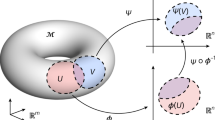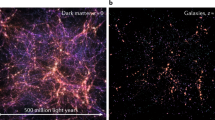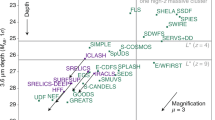Abstract
It goes without saying that we are stuck with the Universe we have. Nevertheless, we would like to go beyond simply describing our observed Universe, and try to understand why it is that way rather than some other way. When considering both the state in which we find our current Universe, and the laws of physics it obeys, we discover features that seem remarkably unnatural to us. Physicists and cosmologists have been exploring increasingly ambitious ideas in an attempt to explain how surprising aspects of our Universe can arise from simple dynamical principles.
This is a preview of subscription content, access via your institution
Access options
Subscribe to this journal
Receive 51 print issues and online access
$199.00 per year
only $3.90 per issue
Buy this article
- Purchase on Springer Link
- Instant access to full article PDF
Prices may be subject to local taxes which are calculated during checkout

Similar content being viewed by others
References
't Hooft, G. in Recent Developments in Gauge Theories vol. 59 (eds 't Hooft, G. et al.) NATO Advanced Study Institute, Series B: Physics (1980).
Zamolodchikov, A. B. ‘Irreversibility’ of the flux of the renormalization group in a 2-D field theory. JETP Lett. 43, 730–732 (1986).
Cardy, J. L. Is there a c theorem in four-dimensions? Phys. Lett. B 215, 749–752 (1988).
Gaite, J. & O'Connor, D. Field theory entropy and the renormalization group. Phys. Rev. D 54, 5163–5173 (1996).
Riess, A. G. et al. Observational evidence from supernovae for an accelerating universe and a cosmological constant. Astron. J. 116, 1009–1038 (1998).
Perlmutter, S. et al. Measurements of Omega and Lambda from 42 high-redshift supernovae. Astrophys. J. 517, 565–586 (1999).
Spergel, D. N. et al. First year Wilkinson Microwave Anisotropy Probe (WMAP) observations: determination of cosmological parameters. Astrophys. J. 148 (suppl.), 175–194 (2003).
Carroll, S. M. The cosmological constant. Living Rev. Rel. 4, 1 (2001).
Penrose, R. in The Emperor's New Mind Ch. 7 (Oxford Univ. Press, Oxford, 1989).
Guth, A. H. The inflationary universe: a possible solution to the horizon and flatness problems. Phys. Rev. D 23, 347–356 (1981).
Linde, A. D. A new inflationary universe scenario: a possible solution of the horizon, flatness, homogeneity, isotropy and primordial monopole problems. Phys. Lett. B 108, 389–393 (1982).
Albrecht, A. & Steinhardt, P. J. Cosmology for grand unified theories with radiatively induced symmetry breaking. Phys. Rev. Lett. 48, 1220–1223 (1982).
Linde, A. D. Chaotic inflation. Phys. Lett. B 129, 177–181 (1983).
Vachaspati, T. & Trodden, M. Causality and cosmic inflation. Phys. Rev. D 61, 023502 (2000).
Guth, A.H. & Pi, S.Y. Fluctuations in the new inflationary universe. Phys. Rev. Lett. 49, 1110–1113 (1982).
Hawking, S. W. The development of irregularities in a single bubble inflationary universe. Phys. Lett. B 115, 295–297 (1982).
Starobinsky, A. A. Dynamics of phase transition in the new inflationary universe scenario and generation of perturbations. Phys. Lett. B 117, 175–178 (1982).
Bardeen, J. M., Steinhardt, P. J. & Turner, M. S. Spontaneous creation of almost scale-free density perturbations in an inflationary universe. Phys. Rev. D 28, 679–693 (1983).
Hollands, S. & Wald, R. M. An alternative to inflation. Gen. Rel. Grav. 34, 2043–2055 (2002).
Albrecht, A. & Sorbo, L. Can the Universe afford inflation? 〈arXiv:hep-th/0405270〉 (2004).
Carroll, S. M. & Chen, J. Spontaneous inflation and the origin of the arrow of time. 〈arXiv:hep-th/0410270〉 (2004).
Vilenkin, A. The birth of inflationary universes. Phys. Rev. D 27, 2848–2855 (1983).
Linde, A. D. Eternal chaotic inflation. Mod. Phys. Lett. A 1, 81–85 (1986).
Linde, A. D. Eternally existing selfreproducing chaotic inflationary universe. Phys. Lett. B 175, 395–400 (1986).
Goncharov, A. S., Linde, A. D. & Mukhanov, V. F. The global structure of the inflationary universe. Int. J. Mod. Phys. A 2, 561–591 (1987).
Garriga, J. & Vilenkin, A. Recycling universe. Phys. Rev. D 57, 2230–2244 (1998).
Dutta, S. & Vachaspati, T. Islands in the Lambda-sea. Phys. Rev. D 71, 083507 (2005).
Holman, R. & Mersini-Houghton, L. Why the universe started from a low entropy state. 〈arXiv:hep-th/0511102〉 (2005).
Farhi, E. & Guth, A. H. An obstacle to creating a universe in the laboratory. Phys. Lett. B 183, 149–155 (1987).
Vilenkin, A. Quantum cosmology and the initial state of the Universe. Phys. Rev. D 37, 888–897 (1988).
Farhi, E., Guth, A. H. & Guven, J. Is it possible to create a universe in the laboratory by quantum tunneling? Nucl. Phys. B 339, 417–490 (1990).
Fischler, W., Morgan, D. & Polchinski, J. Quantum nucleation of false vacuum bubbles. Phys. Rev. D 41, 2638–2641 (1990).
Fischler, W., Morgan, D. & Polchinski, J. Quantization of false vacuum bubbles: a Hamiltonian treatment of gravitational tunneling. Phys. Rev. D 42, 4042–4055 (1990).
Linde, A. D. Hard art of the universe creation (stochastic approach to tunneling and baby universe formation). Nucl. Phys. B 372, 421–442 (1992).
Aguirre, A. & Johnson, M. C. Dynamics and instability of false vacuum bubbles. Phys. Rev. D 72, 103525 (2005).
Aguirre, A. & Johnson, M. C. Two tunnels to inflation. 〈arXiv:gr-qc/0512034〉 (2005).
Alberghi, G. L., Lowe, D. A. & Trodden, M. Charged false vacuum bubbles and the AdS/CFT correspondence. J. High Energy Phys. 9907, 020 (1999); published online 23 June 1999 (arXiv:hep-th/9906047).
Hellerman, S. On the landscape of superstring theory in D > 10. 〈arXiv:hepth/0405041〉 (2005).
Adams, A., Liu, X. McGreevy, J., Saltman, A. & Silverstein, E. Things fall apart: topology change from winding tachyons. J. High Energy Phys. 0510, 033 (2005); published online 5 August 2005 (arXiv:hep-th/0502021).
Dijkgraaf, R., Gopakumar, R., Ooguri, H. & Vafa, C. Baby universes in string theory. 〈arXiv:hep-th/0504221〉 (2005).
McGreevy, J. & Silverstein, E. The tachyon at the end of the universe. J. High Energy Phys. 0508, 090 (2005); published online 3 August 2005 (arXiv:hep-th/0506130).
Freivogel, B. et al. Inflation in AdS/CFT. 〈arXiv:hep-th/0510046〉 (2005).
Dyson, L., Kleban, M. & Susskind, L. Disturbing implications of a cosmological constant. J. High Energy Phys. 0210, 011 (2002); published online 14 November 2002 (arXiv:hep-th/0208013).
Bousso, R. & Polchinski, J. Quantization of four-form fluxes and dynamical neutralization of the cosmological constant. J. High Energy Phys. 0006, 006 (2000); published online 26 June 2000 (arXiv:hep-th/0004134).
Feng, J. L., March-Russell, J., Sethi, S. & Wilczek, F. Saltatory relaxation of the cosmological constant. Nucl. Phys. B 602, 307–328 (2001).
Giddings, S. B., Kachru, S. & Polchinski, J. Hierarchies from fluxes in string compactifications. Phys. Rev. D 66, 106006 (2002).
Kachru, S., Kallosh, R., Linde, A. & Trivedi, S. P. De Sitter vacua in string theory. Phys. Rev. D 68, 046005 (2003).
Douglas, M. R. The statistics of string/M theory vacua. J. High Energy Phys. 0305, 046 (2003); published online 24 April 2003 (arXiv:hep-th/0303194).
Ashok, S. & Douglas, M. R. Counting flux vacua. J. High Energy Phys. 0401, 060 (2004); published online 12 January 2004 (arXiv:hep-th/0307049).
Linde, A. Inflation, quantum cosmology and the anthropic principle. 〈arXiv:hepth/0211048〉 (2002).
Vilenkin, A. Predictions from quantum cosmology. Phys. Rev. Lett. 74, 846–849 (1995).
Tegmark, M. What does inflation really predict? J. Cosmol. Astropart. Phys. 0504, 001 (2005); published online 12 October 2004 (arXiv:astro-ph/0410281).
Aguirre, A. On making predictions in a multiverse: conundrums, dangers, and coincidences. 〈arXiv:astro-ph/0506519〉 (2005).
Garriga, J., Schwartz-Perlov, D., Vilenkin, A. & Winitzki, S. Probabilities in the inflationary multiverse. 〈arXiv:hep-th/0509184〉 (2005).
Easther, R., Lim, E. A. & Martin, M. R. Counting pockets with world lines in eternal inflation. 〈arXiv:astro-ph/0511233〉 (2005).
Tegmark, M., Aguirre, A., Rees, M. & Wilczek, F. Dimensionless constants, cosmology and other dark matters. 〈arXiv:astro-ph/0511774〉 (2005).
Weinberg, S. Anthropic bound on the cosmological constant. Phys. Rev. Lett. 59, 2607–2610 (1987).
Vilenkin, A. Quantum cosmology and the constants of nature. 〈arXiv:gr-qc/9512031〉 (1995).
Martel, H., Shapiro, P. R. & Weinberg, S. Likely values of the cosmological constant. Astrophys. J. 492, 29–40 (1998).
Banks, T., Dine, M. & Motl, L. On anthropic solutions of the cosmological constant problem. J. High Energy Phys. 0101, 031 (2001); published online 26 July 2000 (arXiv:hep-th/0007206).
Pogosian, L., Vilenkin, A. & Tegmark, M. Anthropic predictions for vacuum energy and neutrino masses. J. Cosmol. Astropart. Phys. 0407, 005 (2004); published online 26 April 2004 (arXiv:astro-ph/0404497).
Arkani-Hamed, N. & Dimopoulos, S. Supersymmetric unification without low energy supersymmetry and signatures for fine-tuning at the LHC. J. High Energy Phys. 0506, 073 (2005); published online 24 May 2004 (arXiv:hep-th/0405159).
Arkani-Hamed, N., Dimopoulos, S. & Kachru, S. Predictive landscapes and new physics at a TeV. 〈arXiv:hep-th/0501082〉 (2005).
Dine, M., O'Neil, D. & Sun, Z. Branches of the landscape. J. High Energy Phys. 0507, 014 (2005); published online 20 January 2005 (arXiv:hep-th/0501214).
Fox, P. J. et al. Supersplit supersymmetry. 〈arXiv:hep-th/0503249〉 (2005).
Tegmark, M. & Rees, M. J. Why is the CMB fluctuation level 10−5? Astrophys. J. 499, 526 (1998); published online 12 December 1997 (arXiv:astro-ph/9709058).
Graesser, M. L., Hsu, S. D. H., Jenkins, A. & Wise, M. B. Anthropic distribution for cosmological constant and primordial density perturbations. Phys. Lett. B 600, 15–21 (2004).
Garriga, J. & Vilenkin, A. Anthropic prediction for Lambda and the Q catastrophe. 〈arXiv:hep-th/0508005〉 (2005).
Feldstein, B., Hall, L. J. & Watari, T. Density perturbations and the cosmological constant from inflationary landscapes. 〈arXiv:hep-th/0506235〉 (2005).
Aguirre, A. The cold big-bang cosmology as a counter-example to several anthropic arguments. Phys. Rev. D 64, 083508 (2001); published online 12 July 2001 (arXiv:astro-ph/0106143).
Olum, K. D. Conflict between anthropic reasoning and observation. 〈arXiv:grqc/0303070〉 (2003).
Smolin, L. Scientific alternatives to the anthropic principle. 〈arXiv:hep-th/0407213〉 (2004).
Acknowledgements
I thank A. Aguirre, J. Chen, B. Freivogel, J. Polchinski, E. Silverstein and A. Vilenkin for helpful conversations. This work was supported in part by the US Department of Energy, the National Science Foundation, and the David and Lucile Packard Foundation.
Author information
Authors and Affiliations
Additional information
Author Information Reprints and permissions information is available at npg.nature.com/reprintsandpermissions.
Rights and permissions
About this article
Cite this article
Carroll, S. Is our Universe natural?. Nature 440, 1132–1136 (2006). https://doi.org/10.1038/nature04804
Published:
Issue Date:
DOI: https://doi.org/10.1038/nature04804
This article is cited by
-
Two Notions of Naturalness
Foundations of Physics (2019)
-
Putting the Cart Before the Horse: Co-evolution of the Universe and Observers as an Explanatory Hypothesis
Foundations of Science (2018)
-
On the Carroll–Chen Model
Journal for General Philosophy of Science (2017)
-
The Mathematical Universe
Foundations of Physics (2008)
-
Astrophysics in 2006
Space Science Reviews (2007)
Comments
By submitting a comment you agree to abide by our Terms and Community Guidelines. If you find something abusive or that does not comply with our terms or guidelines please flag it as inappropriate.



